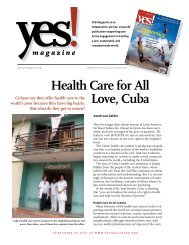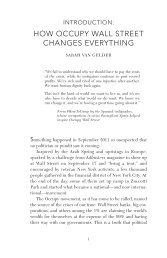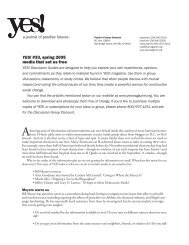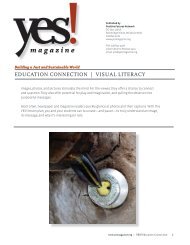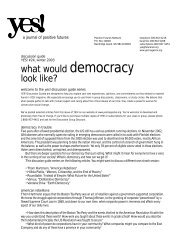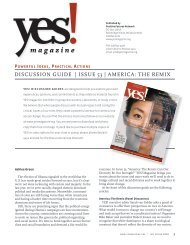Using YES! Stories in the Classroom Lesson Plan ... - YES! Magazine
Using YES! Stories in the Classroom Lesson Plan ... - YES! Magazine
Using YES! Stories in the Classroom Lesson Plan ... - YES! Magazine
- No tags were found...
Create successful ePaper yourself
Turn your PDF publications into a flip-book with our unique Google optimized e-Paper software.
<strong>Us<strong>in</strong>g</strong> <strong>YES</strong>! <strong>Stories</strong> <strong>in</strong> <strong>the</strong> <strong>Classroom</strong><strong>Lesson</strong> <strong>Plan</strong> Guidel<strong>in</strong>es<strong>YES</strong>! for Youth curriculum materials are based on articles published <strong>in</strong> <strong>the</strong> pages of adfree<strong>YES</strong>! magaz<strong>in</strong>e. They are designed to help students explore positive solutions tosocial justice and environmental challenges.For each selected <strong>YES</strong>! article we've developed a set of questions for students that offers<strong>the</strong>m <strong>the</strong> opportunity to demonstrate <strong>the</strong>ir comprehension and critical th<strong>in</strong>k<strong>in</strong>g skills. TheQuestions for Students worksheets can be modified to fit a variety of grade levels,learn<strong>in</strong>g styles and teach<strong>in</strong>g approaches.<strong>YES</strong>! for Youth Curricula:<strong>YES</strong>! article, Questions for Students, and GlossariesObjectivesStudents will:• demonstrate a basic understand<strong>in</strong>g of <strong>the</strong> author’s major <strong>the</strong>sis and arguments• def<strong>in</strong>e and describe new vocabulary terms• comprehend <strong>the</strong> central concepts and/or issues raised <strong>in</strong> <strong>the</strong> article• make a connection between <strong>the</strong> concepts <strong>in</strong> <strong>the</strong> article and <strong>the</strong>ir own lives• express <strong>the</strong>ir own views (<strong>in</strong> writ<strong>in</strong>g and/or <strong>in</strong> discussion)Time requiredGrades 6-12For 1-2 page articles, at least 20 m<strong>in</strong>utes is needed for students to read and complete <strong>the</strong>supplemental worksheet <strong>in</strong> class. For 3-4 page articles, 50 m<strong>in</strong>utes is needed. Additionaltime may be needed to facilitate discussions us<strong>in</strong>g <strong>the</strong> students' answers to <strong>the</strong> questions.This can be done <strong>in</strong> small groups and with <strong>the</strong> class as a whole.If <strong>the</strong> Questions for Students assignment is given as homework, teachers may opt to havea 5 or 10-m<strong>in</strong>ute pre-read<strong>in</strong>g discussion to prepare <strong>the</strong>m for <strong>the</strong> assignment. A postread<strong>in</strong>gdiscussion of 10-15 m<strong>in</strong>utes would give students an opportunity to share answersand reflections. Pre-read<strong>in</strong>g could <strong>in</strong>clude def<strong>in</strong><strong>in</strong>g terms and creat<strong>in</strong>g a context for <strong>the</strong>article's topic. Post-read<strong>in</strong>g discussions could <strong>in</strong>clude ask<strong>in</strong>g what/how/why questions toascerta<strong>in</strong> specific parts of <strong>the</strong> story that resonated with students, to f<strong>in</strong>d out what <strong>the</strong>ythought was miss<strong>in</strong>g from <strong>the</strong> story, and to share ideas about how to move beyond <strong>the</strong>story, and to <strong>in</strong>corporate any lessons learned and new ideas <strong>in</strong>to <strong>the</strong>ir school or localcommunity.
MaterialsThe article(s), Questions for Students worksheets, Glossaries, additional paper (optional)Suggested <strong>Lesson</strong> Structure1. Have students read <strong>the</strong> article <strong>in</strong>dividually, or aloud as a class (with students tak<strong>in</strong>gturns).2. Advise students to underl<strong>in</strong>e words that are new to <strong>the</strong>m as <strong>the</strong>y read through <strong>the</strong>article. Work<strong>in</strong>g alone or <strong>in</strong> teams, ask students to use <strong>the</strong> glossary to look up and review<strong>the</strong> mean<strong>in</strong>g of <strong>the</strong> vocabulary terms <strong>the</strong>y underl<strong>in</strong>ed. The glossary could also be readaloud and used as a pre-read<strong>in</strong>g preparation exercise for <strong>the</strong> class as a whole.3. Ask students to complete <strong>the</strong> Questions for Students worksheet. Students will answer avariety of comprehension and critical-th<strong>in</strong>k<strong>in</strong>g questions <strong>in</strong> writ<strong>in</strong>g. They may needadditional paper, or to use <strong>the</strong> back of <strong>the</strong> worksheet for longer answers.4. Lead a discussion (or have students lead <strong>the</strong> discussion) about <strong>the</strong> article's ma<strong>in</strong> <strong>the</strong>sis,us<strong>in</strong>g <strong>the</strong> Questions for Students as a guide.



